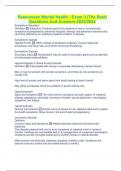Rasmussen Mental Health - Exam 3 (The Best) Questions And Answers 2023/2024 Somatoform Disorders Definition ✅ Subjective Characterized by the presence of one or more physical symptoms accompanied by abnormal thoughts, feelings, and behavioral reactions that cannot be defined by an underlying medical condition or disease. Somatoform disorder Highest Priority ✅ Often undergo unnecessary surgeries, invasive diagnostic procedures, and drug trials, all of which can be life -threatening. Somatoform Disorder Secondary Gains ✅ Somatization may be used for secondary gains such as attention and decreased responsibilities. Hypochondriasis or Illness Anxiety Disorder Definition ✅ Preoccupied with having or eventually developing a serious illness. May or may not present with somatic symptoms, and if they do, the symptoms are usually mild. High level of anxiety and alarm about their health lasting at least 6 month. May either excessively check for problems or avoid medical care. Hypochondriasis Signs and Symptoms ✅ The most common symptoms are pain, gastric or intestinal distress, palpitations, dizziness, shortness of breath, sexual dysfunction, neurological symptoms, and fatigue. Hypochondriasis Nursing Interventions ✅ Nurses role is to assess for any objective data and to explain the health complaints. Show concern, but avoid fostering dependency. Conversion Disorder Definition Common Signs and Symptoms ✅ Medical disorder (objective) that cannot be explained. This disorder presents with one or more symptoms of impaired motor or sensory function. Findings are incompatible with or an exaggeration of recognized neurological conditions and are not better explained by another mental or medical disorder. Most common are blindness, deafness, paralysis, inability to talk. Symptoms are beyond conscious control and are related directly to conflict . Conversion Disorder Nursing Interventions ✅ Encourage independence in ADL's in a matter of fact manner. Dissociative Disorders Definition ✅ A disturbance in the normally well -integrated continuum of consciousness, memory, identity, and perception. Dissociation is an unconscious defense mechanism to protect the individual against overwhelming anxiety related to past trauma, and ranges from minor to severe in presentation. Patients with dissociative disorders have intact reality testing, meaning they are not delusional or hallucinating. Dissociative Fugue ✅ The patient in a fugue state frequently relocates and assumes a new identity while not recalling previous identity or places previously inhabited. The distracters are more consistent with paranoid schizophrenia, generalized anxiety disorder, or bipolar disorder. Head injury, posttraumatic stress disorder, or a neurological disorder should also be considered. Dissociative Amnesia ✅ Related to a traumatic incident, and may be accompanied by a fugue where the patient flees from their normal life to another location and starts a new life. Gradually over time, memories of the original life may be triggered. Patients can become confused and embarrassed when the amnesia subsides and memory returns. Dissociative Identity Disorder ✅ The most severe of the dissociative disorders. Disruption of identity by two or more distinct personality states. Involves discontinuity in the sense of self, accompanied by alterations in affect, behavior, memory, and functioning. Patients lose time, mea ning they do not have memory of periods of time ranging from minutes to weeks. The patient is often unaware of the other personalities. Each alternate personality has its own pattern of personality, perception, and memories. Body Dysmorphic Disorder Definition ✅ A highly distressing and impairing disorder that ranges along the continuum from distressing to delusional severity. They have preoccupation with an imagined defective body part; obsessional thinking, compulsive behaviors. Individuals with BDD are frequently concerned with the face, skin, genitalia, thighs, hips, and hair.




